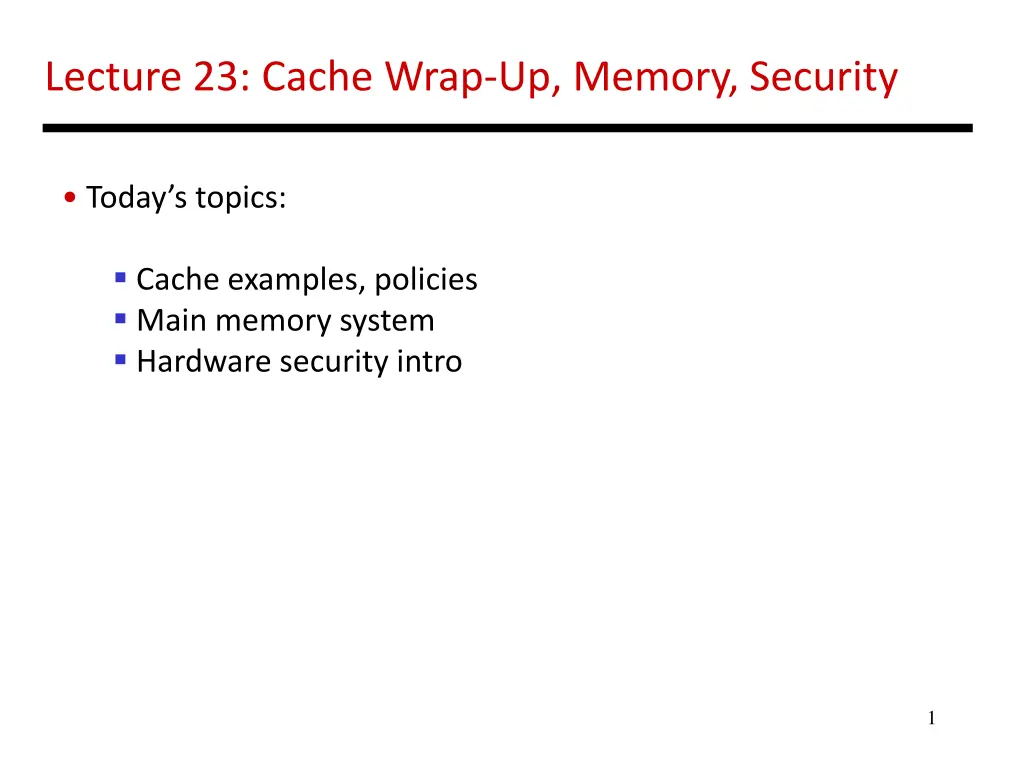
Understanding Cache, Memory, and Security in Computer Systems
Explore cache examples, policies, memory systems, and hardware security concepts in computer architecture. Learn how to map addresses to caches, differentiate cache hits and misses, and understand cache replacement policies. Delve into the impact of write misses and write strategies on cache behavior.
Download Presentation

Please find below an Image/Link to download the presentation.
The content on the website is provided AS IS for your information and personal use only. It may not be sold, licensed, or shared on other websites without obtaining consent from the author. If you encounter any issues during the download, it is possible that the publisher has removed the file from their server.
You are allowed to download the files provided on this website for personal or commercial use, subject to the condition that they are used lawfully. All files are the property of their respective owners.
The content on the website is provided AS IS for your information and personal use only. It may not be sold, licensed, or shared on other websites without obtaining consent from the author.
E N D
Presentation Transcript
Lecture 23: Cache Wrap-Up, Memory, Security Today s topics: Cache examples, policies Main memory system Hardware security intro 1
Example 2 Show how the following addresses map to the cache and yield hits or misses. The cache is direct-mapped, has 16 sets, and a 64-byte block size. Addresses: 8, 96, 32, 480, 976, 1040, 1096 Offset = address % 64 (address modulo 64, extract last 6) Index = address/64 % 16 (shift right by 6, extract last 4) Tag = address/1024 (shift address right by 10) 32-bit address 22 bits tag 4 bits index 6 bits offset 8: 0 0 8 M 96: 0 1 32 M 32: 0 0 32 H 480: 0 7 32 M 976: 0 15 16 M 1040: 1 0 16 M 1096: 1 1 8 M . . . 2
Example 4 Assume that addresses are 8 bits long How many of the following address requests are hits/misses? 4, 7, 10, 13, 16, 24, 36, 4, 48, 64, 4, 36, 64, 4 Byte address 00010000 Tag Way-1 Way-2 8-byte blocks Tag array Data array 3
Example 4 Assume that addresses are 8 bits long How many of the following address requests are hits/misses? 4, 7, 10, 13, 16, 24, 36, 4, 48, 64, 4, 36, 64, 4 M H M H M M M H M M H M M M Byte address 00010000 Tag Way-1 Way-2 8-byte blocks Tag array Data array 4
Cache Misses On a write miss, you may either choose to bring the block into the cache (write-allocate) or not (write-no-allocate) On a read miss, you always bring the block in (spatial and temporal locality) but which block do you replace? no choice for a direct-mapped cache randomly pick one of the ways to replace replace the way that was least-recently used (LRU) FIFO replacement (round-robin) 5
Writes When you write into a block, do you also update the copy in L2? write-through: every write to L1 write to L2 write-back: mark the block as dirty, when the block gets replaced from L1, write it to L2 Writeback coalesces multiple writes to an L1 block into one L2 write Writethrough simplifies coherency protocols in a multiprocessor system as the L2 always has a current copy of data 6
Types of Cache Misses Compulsory misses: happens the first time a memory word is accessed the misses for an infinite cache Capacity misses: happens because the program touched many other words before re-touching the same word the misses for a fully-associative cache Conflict misses: happens because two words map to the same location in the cache the misses generated while moving from a fully-associative to a direct-mapped cache 7
Off-Chip DRAM Main Memory Main memory is stored in DRAM cells that have much higher storage density DRAM cells lose their state over time must be refreshed periodically, hence the name Dynamic A number of DRAM chips are aggregated on a DIMM to provide high capacity a DIMM is a module that plugs into a bus on the motherboard DRAM access suffers from long access time and high energy overhead 8
Memory Architecture Bank Row Buffer Processor Memory Controller Address/Cmd DIMM Data DIMM: a PCB with DRAM chips on the back and front The memory system is itself organized into ranks and banks; each bank can process a transaction in parallel Each bank has a row buffer that retains the last row touched in a bank (it s like a cache in the memory system that exploits spatial locality) (row buffer hits have a lower latency than a row buffer miss) 9
Hardware Security Software security: key management, buffer overflow, etc. Hardware security: hardware-enforced permission checks, authentication/encryption, etc. Information leakage, side channels, timing channels Meltdown, Spectre, SGX/TDX 10
Meltdown 11
Spectre: Variant 1 x is controlled by attacker Thanks to bpred, x can be anything array1[ ] is the secret if (x < array1_size) y = array2[ array1[x] ]; Victim Code Access pattern of array2[ ] betrays the secret 12
Spectre: Variant 2 Victim code R1 (from attacker) R2 some secret Label0: if ( ) Attacker code Label0: if (1) Label1: Victim code Label1: lw [R2] 13
